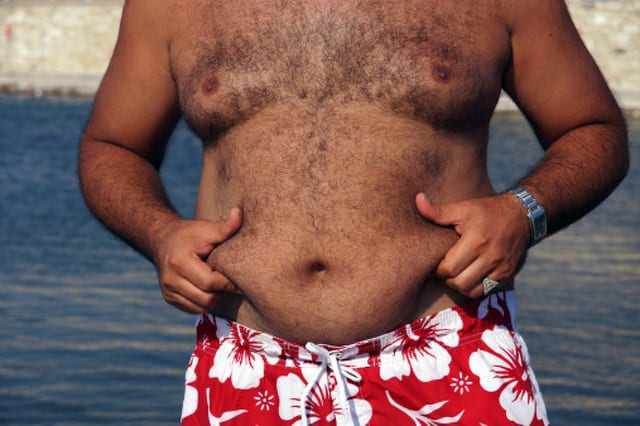One of the fun activities of vacationing at the beach is people-watching. Watching the little ones excitedly plan in the sand and water. Teenagers playing with a skim board or boogie board. Older couples riding their bikes through the hardened sand. Families playing a beach version of the games that are often played at tailgate parties. Kids making new friends as they share the ocean experience.
Watching people have fun and play can be entertaining and adds to the enjoyment of the vacation experience.
We had been sitting on the beach for several hours yesterday when a family arrived to set up their spot. The family configuration was pretty typical, parents carrying beach chairs and pulling a cooler and their sons and what looked like the eldest son’s girlfriend carrying their own towels and water toys. What caught my eye about this family was their size. While all of the family members would likely be identified by health standards as obese, the youngest son, a boy who looked to be about 8 or 9 years old, easily weighed 300 pounds.
It was sad to watch as he tried to keep up with the other kids who were running and jumping and looking for that great wave. My heart broke for him.
If one has any doubt about our nation’s obesity crisis, spend some time on a beach.
Obesity, as we know, is one of the top medical concerns for today’s Americans. Although genetics plays a minor role in our body shapes, our decisions have the greatest impact on our weight. We eat too much. We eat the wrong things. Fast food and “fat free” products have served to make us fat – fast. Our jobs and our lives are more sedentary than those of our forefathers and mothers. We exercise less and eat more than we did even 30 years ago. The economy plays a role in our diet; good food is often more expensive and harder to access. The ripple effect of obesity in terms of health, education, employment and other social and emotional concerns cannot be understated.
What can this little boy look potentially look forward to if he doesn’t make a lifestyle change? Cardio-vascular concerns. Heart concern. Diabetes. Sleep disorders. Orthopedic issues. The American Pediatric Association cites a report that says 20% of 5-10 year olds who are obese have early signs of at least one risk factor for cardiac disease including high cholesterol or high blood pressure. Type 2 diabetes, the form that generally shows up in adults related to lifestyle decisions, is also on the rise among obese children.
Children with obesity are also more prone to sleep issues such as sleep apnea which can lead to additional medical and educational issues – and cause weight gain.
And then there are the social issues. Scientists have found that kids who are overweight suffer from significant social problems. Bullying in overweight kids – both as the target and as the bully – is reported more frequently than with their same age peers who are thinner. Studies have found that children find overweight children to be “less likable.” Children who are overweight often report lower self-esteem and greater social isolation and depression than their same age peers. These social and medical issues can impact how a child is able to function and learn in a school setting.
As I watched this little guy running down to the waves, holding out his boogie board because his belly and his legs were so big, I couldn’t help but think what his future holds. Middle school can be especially cruel and it doesn’t get much easier after that.
In an age wherewe are watching a generation of kids get fat and fatter, we are also seeing a decrease in unstructured play (recess) at school and the reduction of physical education time in the school day.
Sometimes things don’t make sense.
It is estimated that 80% of teenagers who are obese will remain obese as adults. The risk of serious health problems for teens and adults increases to the point that can be a real and serious risk. Socially, it has been documented that teens and adults who are obese face greater discrimination in a variety of settings including higher education admissions, employment, and other work force situations (i.e. promotion, wages). Further, studies have shown that both men and women who are obese have fewer friends and have greater difficulty finding a marriage/partner.
Adding to this already complicated epidemic, researchers in the United States and Great Britain have found that up to 95% of parents of children who are overweight identify their child as being “just about right” in terms of the child’s weight compared to peers.
In other words, if someone asked the mom of the little boy I saw, red faced and straining to keep up with his peers in a game of beach paddleball, if there was a problem with his weight, there is a good chance she would not see it.
Sadly, the solutions to obesity as a national concern are very complicated. How do we hold parents responsible for keeping their children safe and healthy while maintaining personal rights? How can the medical community help out? Programs like Michelle Obama’s “Let’s Move” campaign against childhood obesity has helped to bring the debate to the national stage. Schools and churches have jumped on board to help people work together to address this growing national crisis. People often misunderstand the long term impact that obesity is having on many of our society’s support systems.
The image of that little boy will stick with me for a while. As he laughed and screamed and played along with the other boys, I thought of how much better his quality of life would be if didn’t have to carry that burden. How do we help him and so many others like him?



